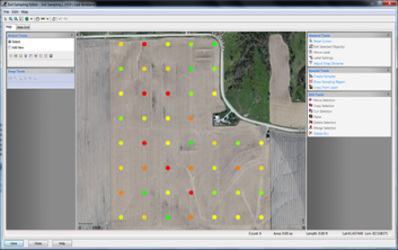What is Precision Agriculture?
Precision Farming has changed how we farm. GPS auto-steer helps us be much more efficient with planting and pesticide/fertilizer applications. With sub-inch accuracy there is no overlaps in the field which means applying only exactly what is needed. Controlled drainage water management reduces the flow of fertilizers into the surface waters by holding back drainage waters when the soil can absorb it. The data collected by GPS Yield maps, soil sampling maps, drone flight maps all help us create management zones in the fields. These management zones then get variable rate fertilizer application, as each zone requires. This new farming practices are all great benefits to our environment!!!

Advanced Seed Monitoring
GPS seed monitoring now offers complete planter monitoring functions the are benefits:
GPS seed monitoring now offers complete planter monitoring functions the are benefits:
- Variable rate planting: Maximize yield based on variations in the field.
- AutoSwath automatic shut-offs: Eliminate overplanting at point rows and already-planted areas.
- Advanced Seed Monitoring: Reduce doubles and skips, and improve spacing with seed-by-seed views of your row units.
- Down Force Pressure: Plant at proper seed depth across the planter toolbar.
- Year Round Displays: GPS displays map and record all your field activities – from planting through harvest.

GPS Auto-Steer: Work Smarter
Guidance and steering benefits:
Guidance and steering benefits:
- Reduce fatigue while extending the work day.
- Lower fuel and input costs and increase yield potential by decreasing gaps and overlaps.
- Deliver fertilizer directly to the seed trench more accurately.
- Level of accuracy is down to sub-inch.

Yield Monitoring:
- Instantly see yields as you go across the field & notice the soil/yield difference in different areas
- Improve understanding of seed types and other field activities on yield.
- Gather more reliable yield data.
- Make real-time yield comparisons.
- View moisture maps in real-time for instant feedback on performance.
- Improve seed selections based on yield data over multiple years.
- Decide how to store your grain based on moisture readings in the field.

Soil Test Analysis
The soil testing is used to measure various soil components such as P and K and micro-nutrients serves us well in determining if we need further amendments. The soil test is designed to measure a soils ability to supply a given nutrient. A high test indicates a soil has a greater ability to supply and therefore we need less fertilizer and low readings indicate the opposite we need to supply nutrients. These are done in grid map style creating zones of different needs in each field.
The soil testing is used to measure various soil components such as P and K and micro-nutrients serves us well in determining if we need further amendments. The soil test is designed to measure a soils ability to supply a given nutrient. A high test indicates a soil has a greater ability to supply and therefore we need less fertilizer and low readings indicate the opposite we need to supply nutrients. These are done in grid map style creating zones of different needs in each field.

Field Management Zones
A "management zone" is a sub-region of a field that shows the same combination of yield-limiting factors for which a single rate (or management practice) of a specific crop input (or field operation) is appropriate. The establishment of management zones is simply a way of classifying the spatial variability within a field. These management zones allow us to apply fertilizer or even seed by variable rate meaning less or more depending on the needs or capability of each specific zone.
A "management zone" is a sub-region of a field that shows the same combination of yield-limiting factors for which a single rate (or management practice) of a specific crop input (or field operation) is appropriate. The establishment of management zones is simply a way of classifying the spatial variability within a field. These management zones allow us to apply fertilizer or even seed by variable rate meaning less or more depending on the needs or capability of each specific zone.

GPS Land Formation
GPS can be used to shape land, level fields, and create ditches. GPS land forming is a way to change the existing topography of a field to eliminate ponding and improve surface drainage leading to better water management and nutrient absorption, which can lead to higher crop yields.
GPS can be used to shape land, level fields, and create ditches. GPS land forming is a way to change the existing topography of a field to eliminate ponding and improve surface drainage leading to better water management and nutrient absorption, which can lead to higher crop yields.

Controlled Drainage
Controlled Drainage Water Level Control Structures effectively manage the water table in your field by setting stoplogs within the structure to your desired water level height. Management allows for controlled release of outlet flow, retention of valuable nutrients, and effective flood mitigation.
Controlled Drainage Water Level Control Structures effectively manage the water table in your field by setting stoplogs within the structure to your desired water level height. Management allows for controlled release of outlet flow, retention of valuable nutrients, and effective flood mitigation.
